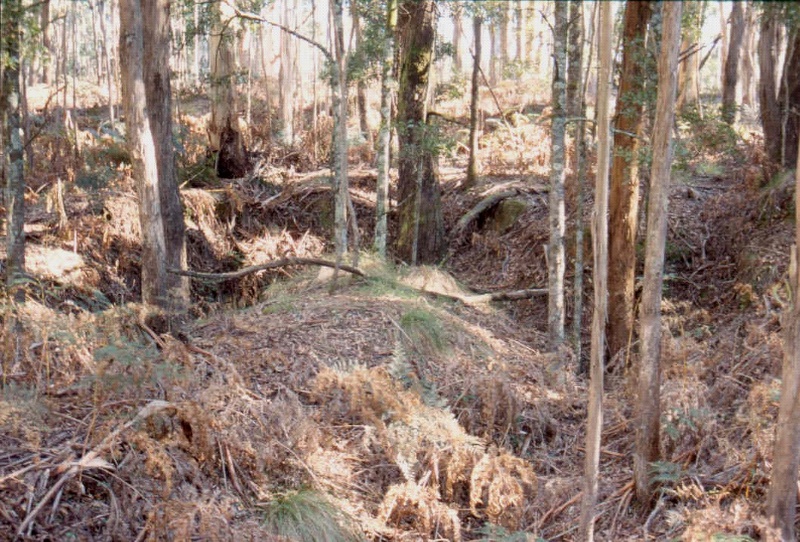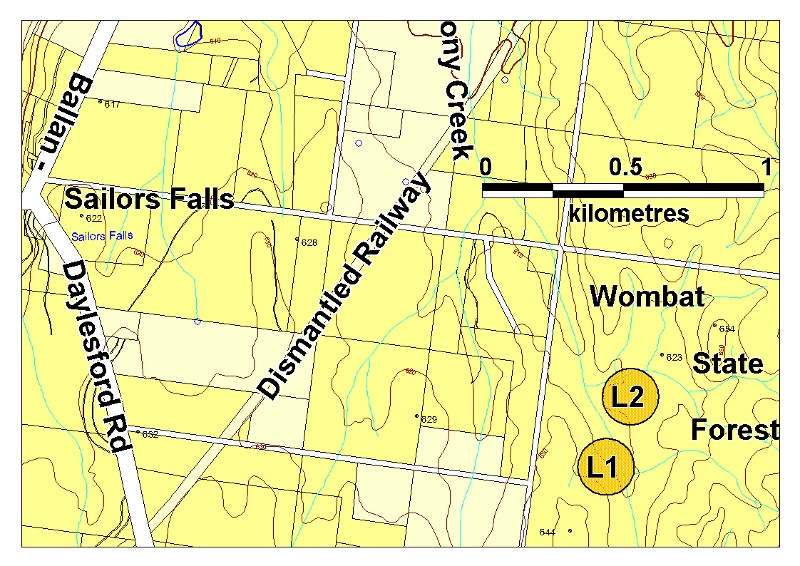TELEGRAPH (GRAVES') SAWMILL
CREAVES MILL TRACK LEONARDS HILL, HEPBURN SHIRE
-
Add to tour
You must log in to do that.
-
Share
-
Shortlist place
You must log in to do that.
- Download report




Statement of Significance
What is significant?
The Telegraph (Graves?) Sawmill represents one of the best preserved nineteenth-century mill sites known in Victoria. Erected south of Daylesford by the Telegraph Sawmill Company in 1872, the mill was managed by George Graves from 1879 until its closure in 1893. The mill features the remains of a deep square pit for the vertical breaking-down saw, a stone boiler setting, a well to supply water, timber impressions for a large log deck and earthworks for the log tramway cutting behind the mill. Evidence for the mill settlement survives in the form of several brick and stone fireplace foundations located on a low mound north of the mill.
How is it significant?
The Telegraph (Graves?) Sawmill is of archaeological significance to the State of Victoria.
Why is it significant?
The Telegraph (Graves?) Sawmill is archaeologically important as a comparatively intact example of a nineteenth-century mill. The remains demonstrate well the layout of the mill and the type of machinery employed. Sawmilling in the Wombat Forest during this period provided timber products which were crucial to the success of the gold mining industry in Victoria. The site has the potential to provide physical evidence relating to the technological history of the timber industry and the cultural history of sawmilling settlements.
-
-
TELEGRAPH (GRAVES') SAWMILL - History
The Telegraph Sawmill Company was formed around 1860 and installed its third mill on the west bank of Stony Creek, south of Daylesford, in 1872. The new mill was powered by a 27 nhp engine, employed twenty men, and cut around 8500 super feet of timber per day. A timber tramway was constructed from the Daylesford-Ballan Road along the Stony Creek valley to connect with the mill, and then extended to near the top of the divide where it turned east. Jinkers were used to bring logs to the tramway.
The mill was managed by Robert Henderson until he left to build a mill of his own in 1879. He was replaced by George Graves. Graves had arrived in Ballarat in 1851 and took up mining until 1855 when he built a sawmill at Mount Warrenheip. Around 1860 he went into partnership with Thomas Fraser. The pair operated a number of mills until 1879 when Graves left to take over the Manager’s role at the Telegraph Mill on Stony Creek. By this time, Graves was accustomed to operating large sawmills, many of which were served by tramways of some kind. Graves sold much of the old plant at the Telegraph Mill and replaced it with a more powerful 40 nhp engine and possibly upgraded the saw benches as well. By this stage the mill was the largest between Woodend and Daylesford. The mill continued operating until its closure in 1893.
TELEGRAPH (GRAVES') SAWMILL - Permit Exemptions
General Exemptions:General exemptions apply to all places and objects included in the Victorian Heritage Register (VHR). General exemptions have been designed to allow everyday activities, maintenance and changes to your property, which don’t harm its cultural heritage significance, to proceed without the need to obtain approvals under the Heritage Act 2017.Places of worship: In some circumstances, you can alter a place of worship to accommodate religious practices without a permit, but you must notify the Executive Director of Heritage Victoria before you start the works or activities at least 20 business days before the works or activities are to commence.Subdivision/consolidation: Permit exemptions exist for some subdivisions and consolidations. If the subdivision or consolidation is in accordance with a planning permit granted under Part 4 of the Planning and Environment Act 1987 and the application for the planning permit was referred to the Executive Director of Heritage Victoria as a determining referral authority, a permit is not required.Specific exemptions may also apply to your registered place or object. If applicable, these are listed below. Specific exemptions are tailored to the conservation and management needs of an individual registered place or object and set out works and activities that are exempt from the requirements of a permit. Specific exemptions prevail if they conflict with general exemptions. Find out more about heritage permit exemptions here.Specific Exemptions:General Conditions: 1. All exempted alterations are to be planned and carried out in a manner which prevents damage to the fabric of the registered place or object. General Conditions: 2. Should it become apparent during further inspection or the carrying out of alterations that original or previously hidden or inaccessible details of the place or object are revealed which relate to the significance of the place or object, then the exemption covering such alteration shall cease and the Executive Director shall be notified as soon as possible. General Conditions: 3. If there is a conservation policy and plan approved by the Executive Director, all works shall be in accordance with it. General Conditions: 4. Nothing in this declaration prevents the Executive Director from amending or rescinding all or any of the permit exemptions. General Conditions: 5. Nothing in this declaration exempts owners or their agents from the responsibility to seek relevant planning or building permits from the responsible authority where applicable.EXEMPTIONS:
* Preliminary Mineral Exploration work
* Fire suppression duties
* Weed and vermin control
* Public safety
* Rehabilitation, protective and stabilisation works
* Information signage - for interpretation and prevention of public risk
-
-
-
-
-
TELEGRAPH (GRAVES') SAWMILL
 Victorian Heritage Register H2016
Victorian Heritage Register H2016
-
'Boonderoo', House and Outbuildings
 Greater Bendigo City
Greater Bendigo City -
'Riverslea' house
 Greater Bendigo City
Greater Bendigo City -
1 Adam Street
 Yarra City
Yarra City
-
-










